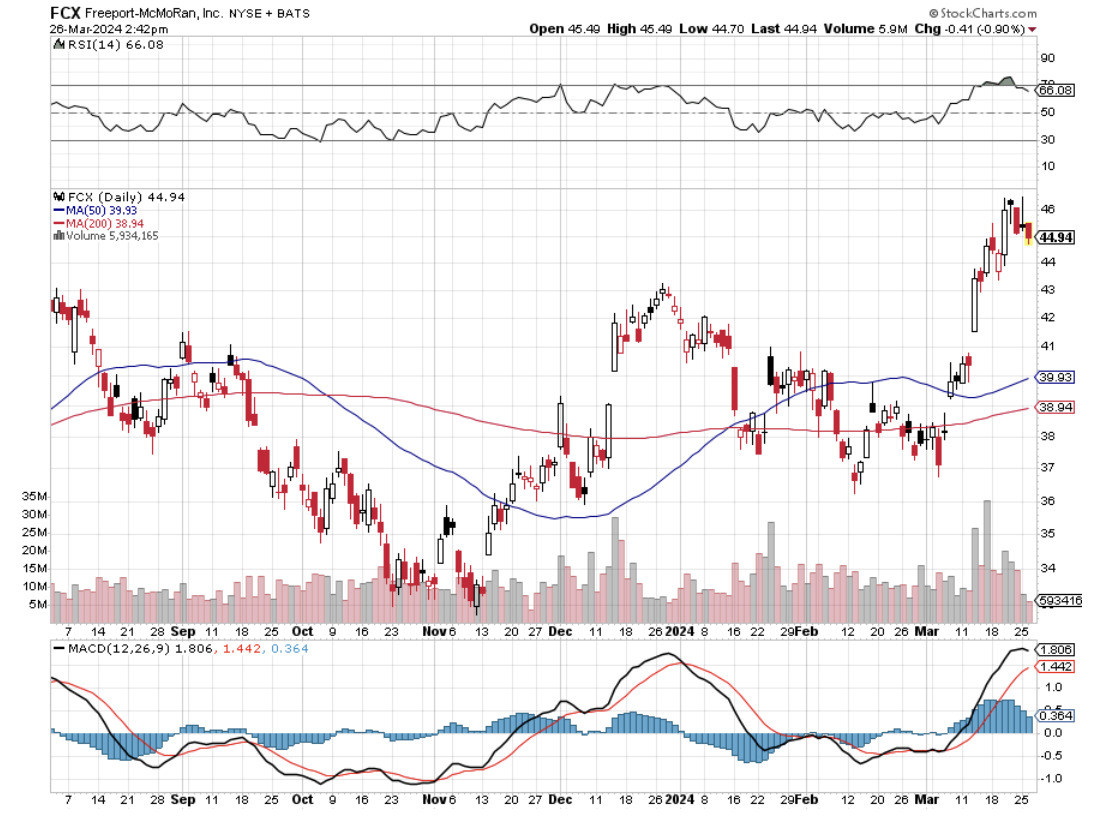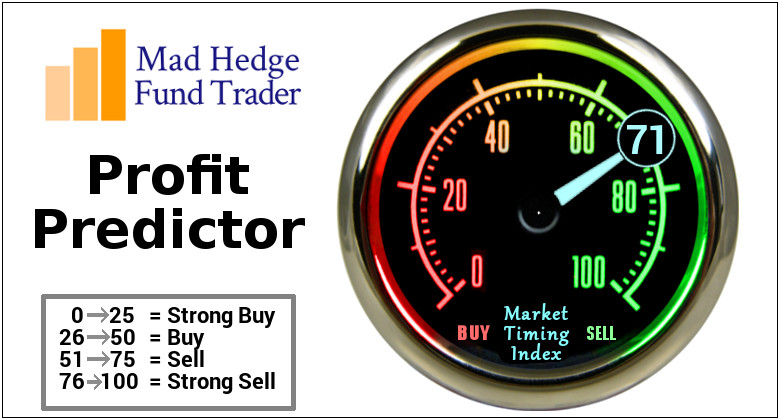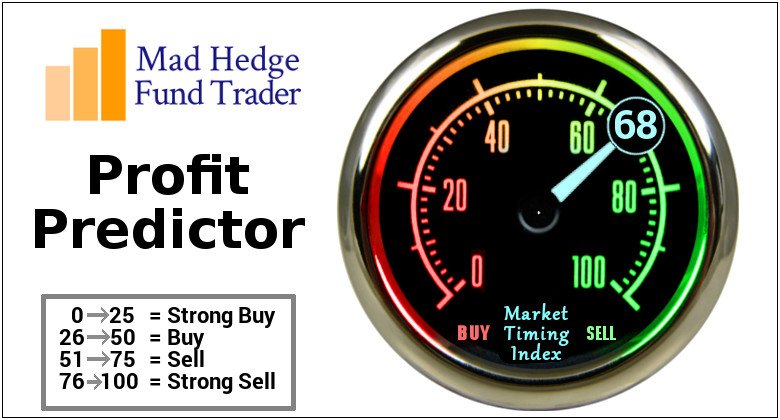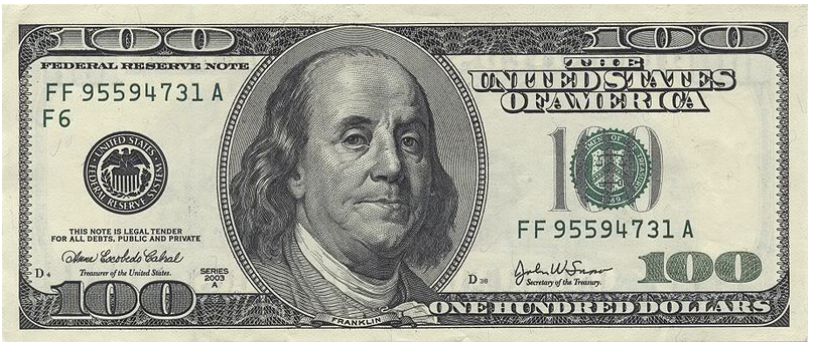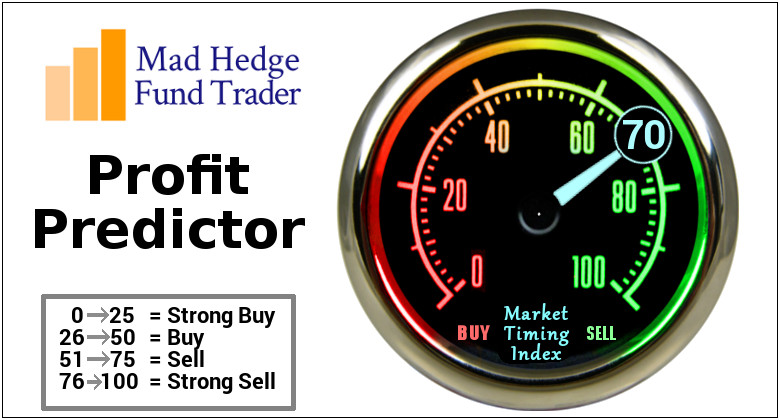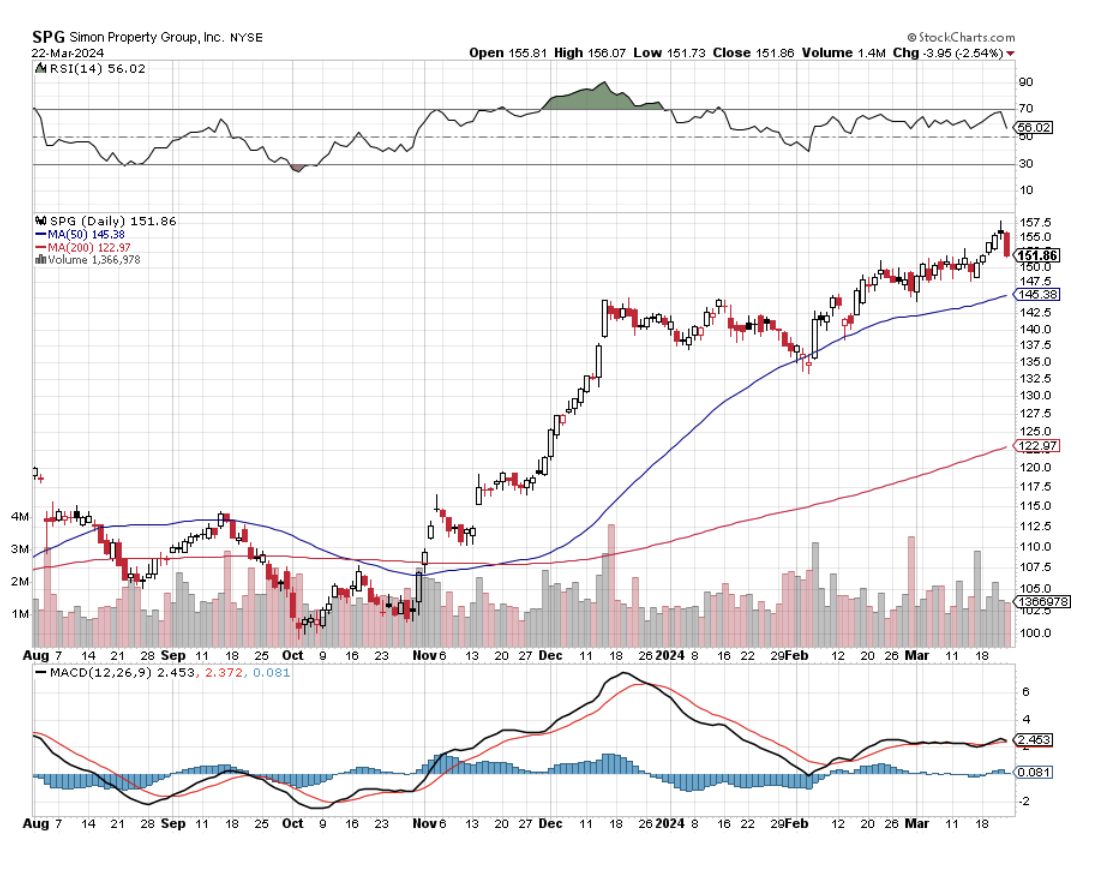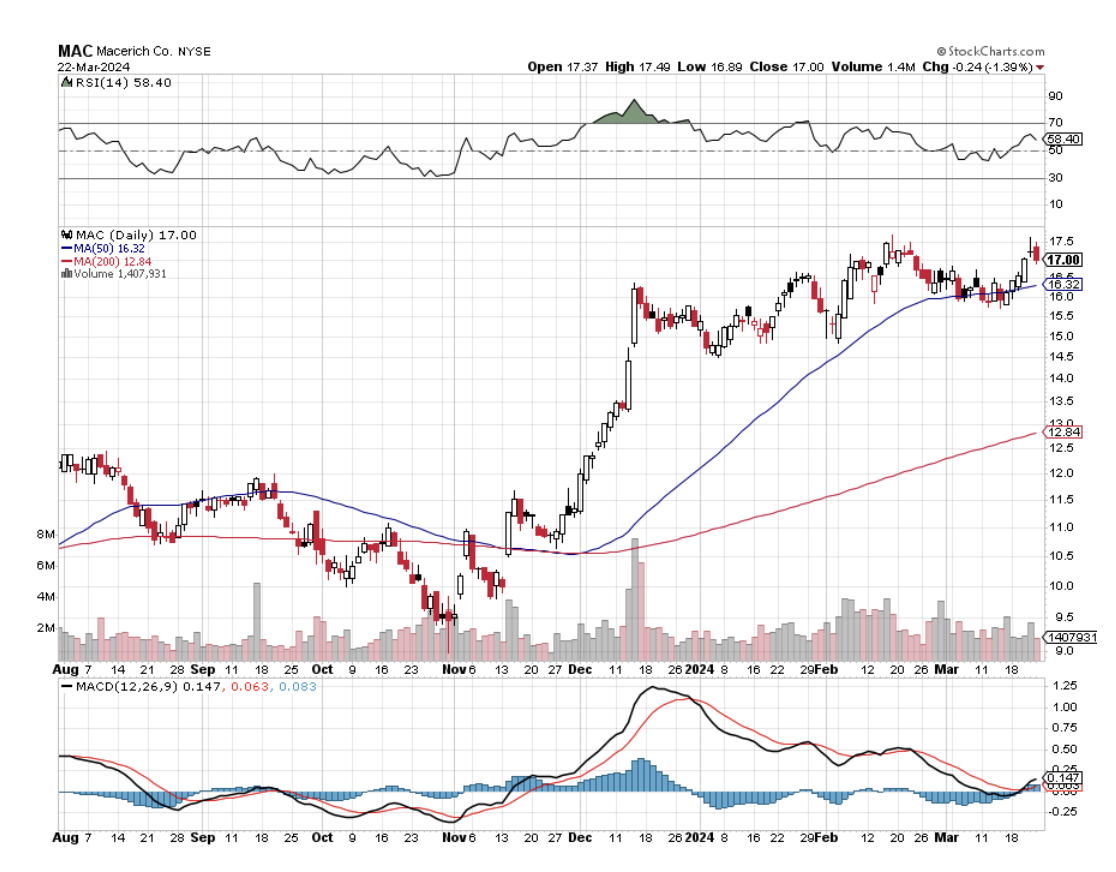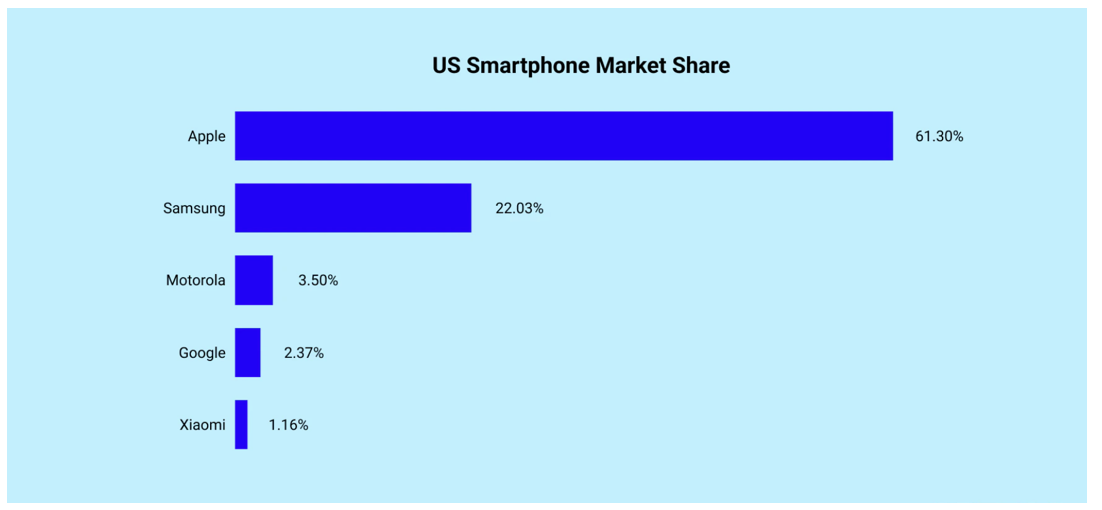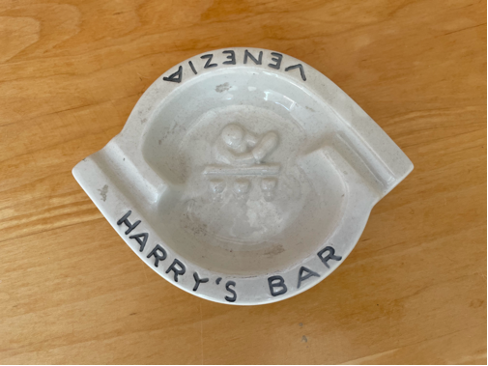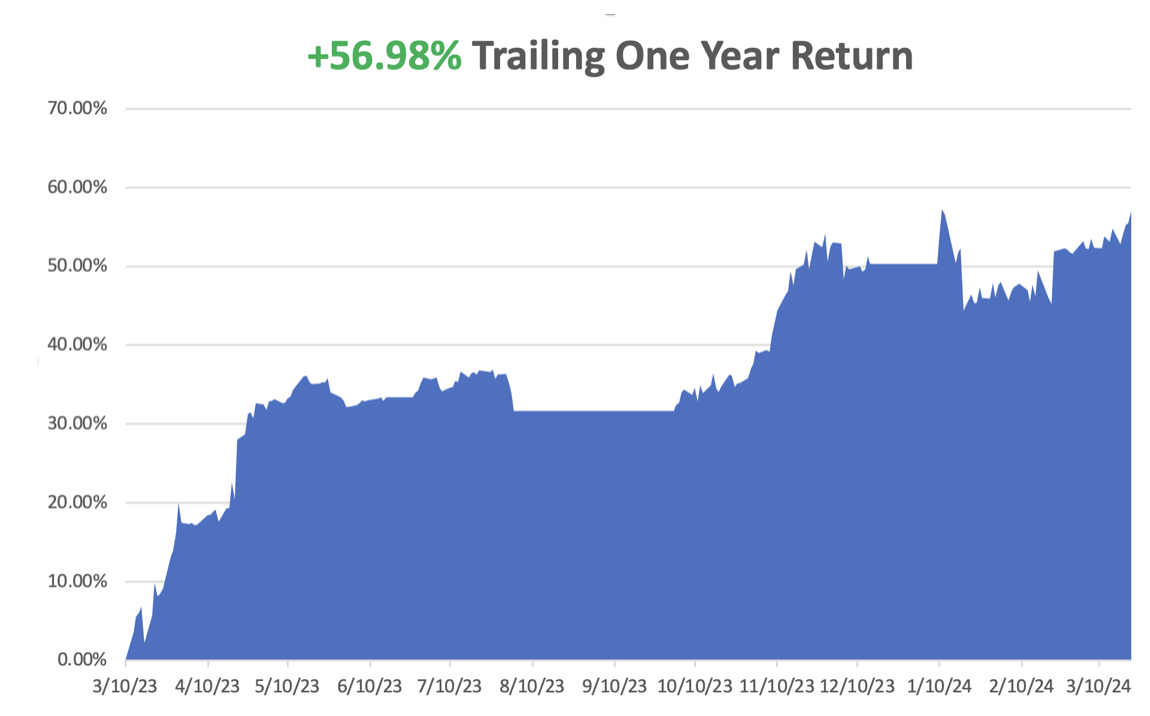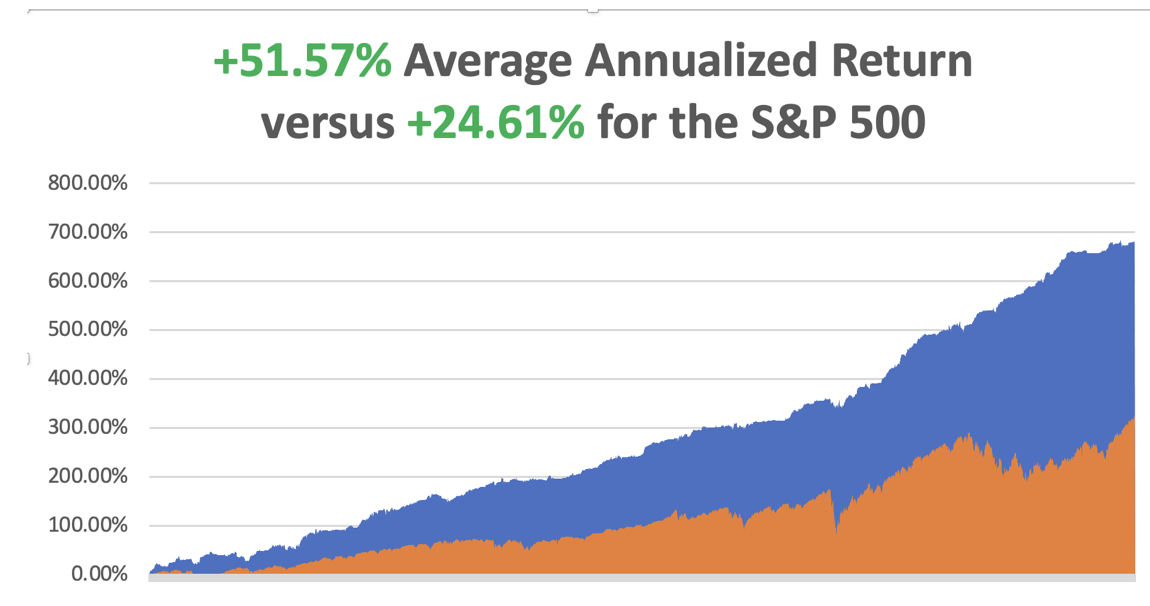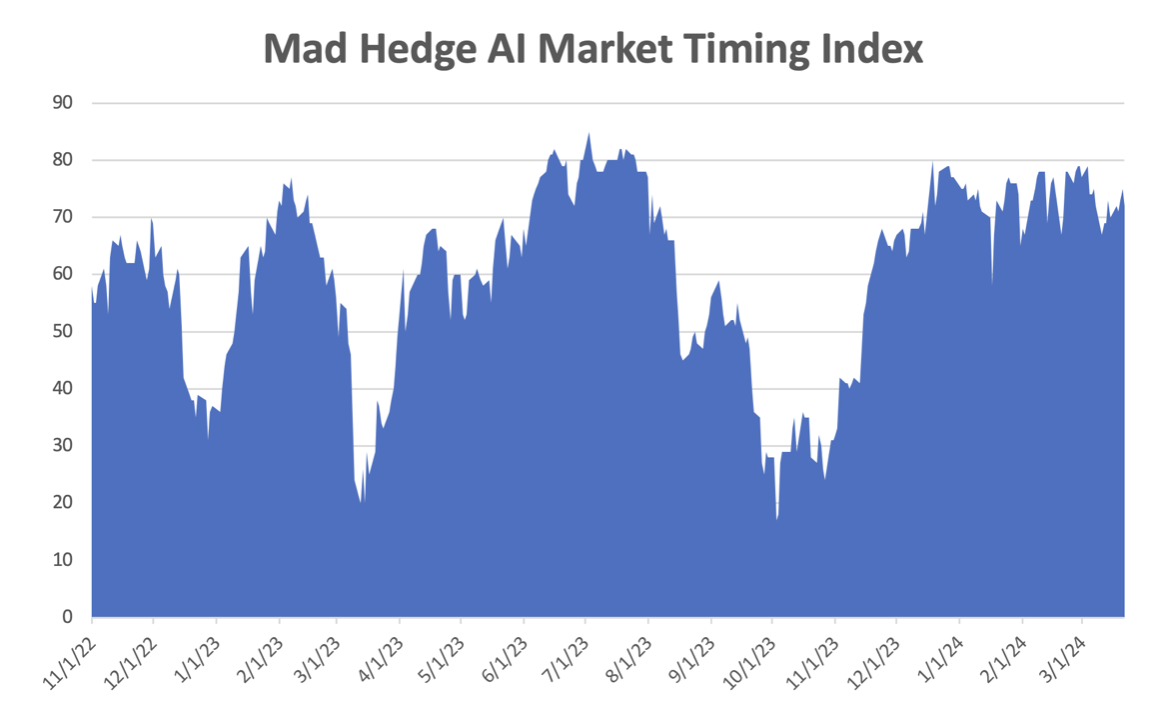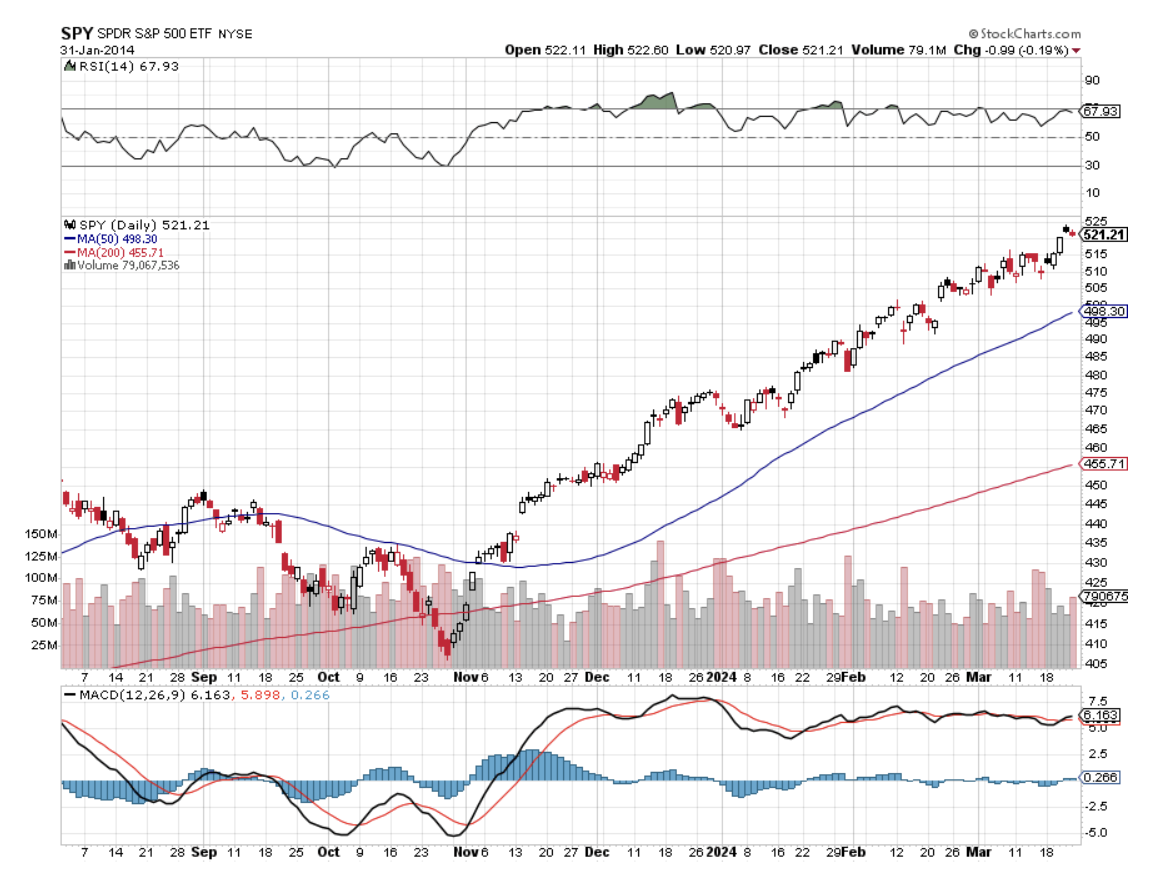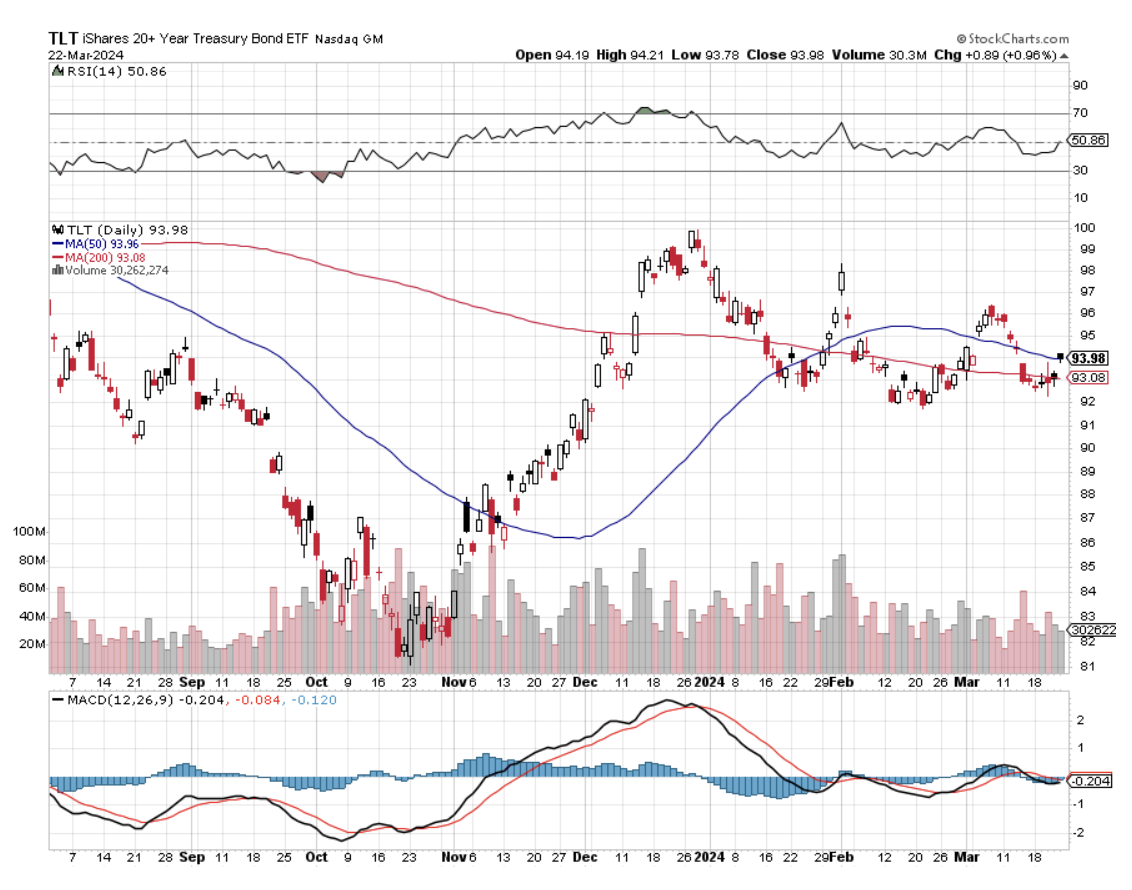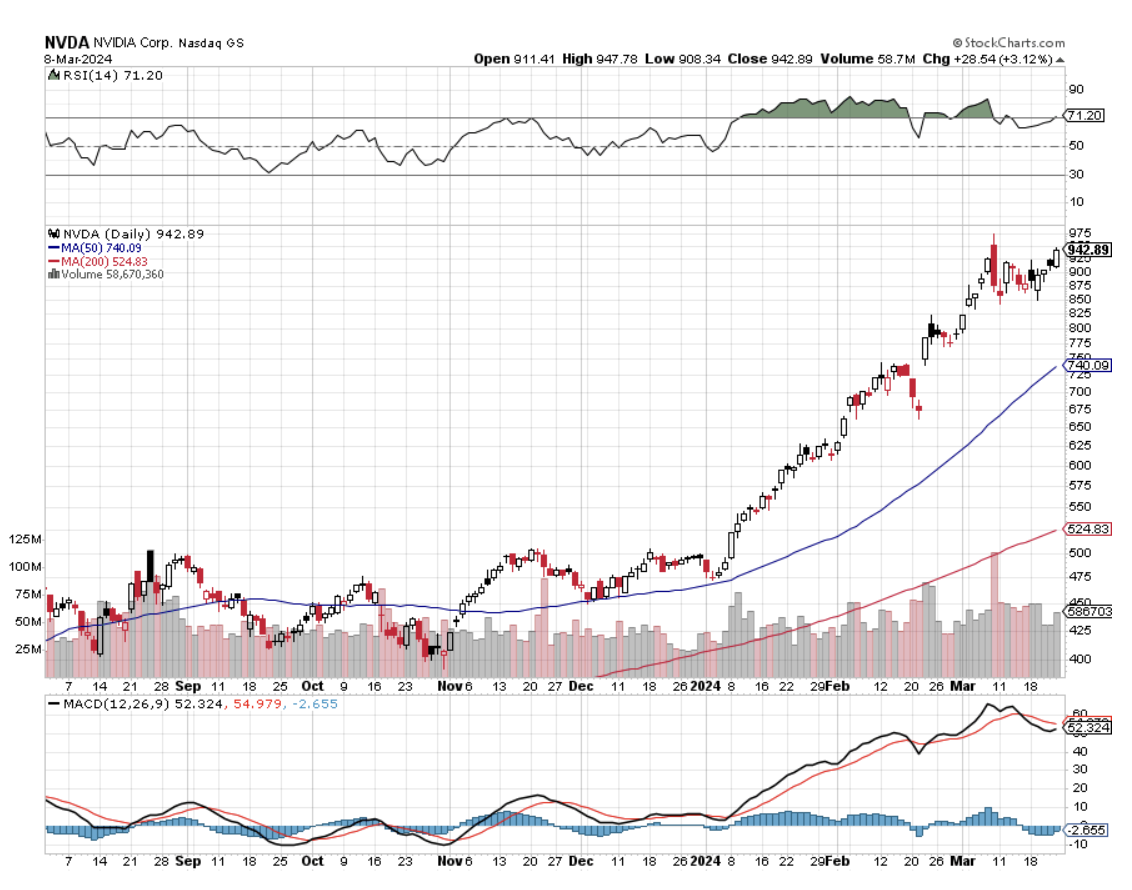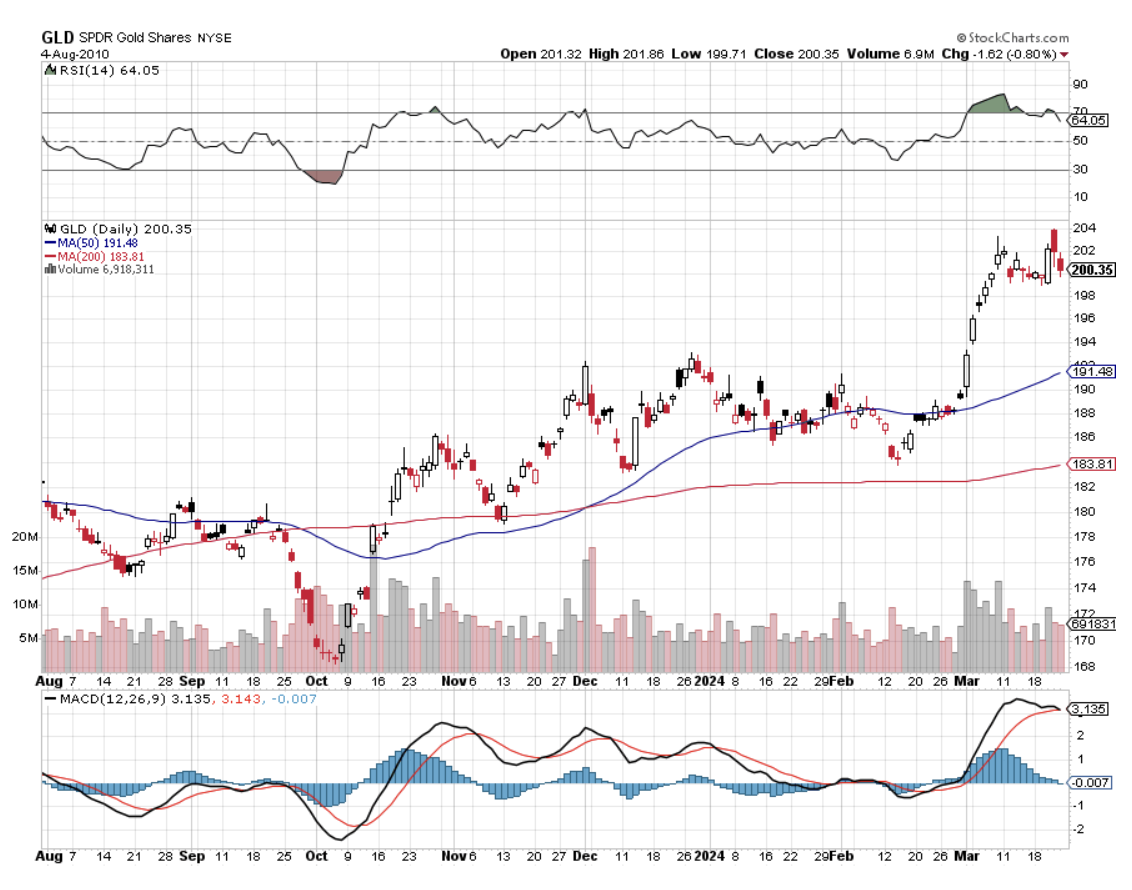
Occasionally I get a call from Concierge members asking what to do when their short positions options were assigned or called away. The answer was very simple: fall on your knees and thank your lucky stars. You have just made the maximum possible profit for your position instantly.
We have the good fortune to have SEVEN spreads that are deep in the money going into the APRIL 19 option expiration. They include:
(TLT) 4/$87-$90 call spread
(FCX) 4/$37-$40 call spread
(XOM) 4/$100-$105 call spread
(OXY) 4/$59-$62 call spread
(WPM) 4/$39-$42 call spread
(TSLA) 4/$140-$150 calls spread
(FCX) 4/48-$51 put spread
In the run-up to every options expiration, which is the third Friday of every month, there is a possibility that any short options positions you have may get assigned or called away.
Most of you have short-option positions, although you may not realize it. For when you buy an in-the-money vertical option spread, it contains two elements: a long option and a short option.
The short options can get “assigned,” or “called away” at any time, as it is owned by a third party, the one you initially sold the put option to when you initiated the position.
You have to be careful here because the inexperienced can blow their newfound windfall if they take the wrong action, so here’s how to handle it correctly.
Let’s say you get an email from your broker telling you that your call options have been assigned away. I’ll use the example of the Freeport McMoRan (FCX) April 2024 $37-$40 in-the-money vertical BULL CALL debit spread.
What the broker had done in effect is allow you to get out of your call spread position at the maximum profit point 10 trading days before the April 19 expiration date. In other words, what you bought for $2.60 on March 4 is now $3.00!
All you have to do is call your broker and instruct them to exercise your long position in your (FCX) April 37 calls to close out your short position in the (FCX) April $40 calls.
This is a perfectly hedged position, with both options having the same expiration date, and the same amount of contracts in the same stock, so there is no risk. The name, number of shares, and number of contracts are all identical, so you have no exposure at all.
Calls are a right to buy shares at a fixed price before a fixed date, and one option contract is exercisable into 100 shares.
To say it another way, you bought the (FCX) at $37 and sold it at $40, paid $2.60 for the right to do so, so your profit is $0.40 cents, or ($0.40 X 100 shares X 40 contracts) = $1,600. Not bad for a 30-day defined limited-risk play.
Sounds like a good trade to me.
Weird stuff like this happens in the run-up to options expirations like we have coming.
A call owner may need to buy a long (FCX) position after the close, and exercising his long April $40 call is the only way to execute it.
Adequate shares may not be available in the market, or maybe a limit order didn’t get done by the market close.
There are thousands of algorithms out there that may arrive at some twisted logic that the calls need to be exercised.
Many require a rebalancing of hedges at the close every day which can be achieved through option exercises.
And yes, options even get exercised by accident. There are still a few humans left in this market to make mistakes.
And here’s another possible outcome in this process.
Your broker will call you to notify you of an option called away, and then give you the wrong advice on what to do about it. They’ll tell you to take delivery of your long stock and then most additional margin to cover the risk.
Either that, or you can just sell your shares on the following Monday and take on a ton of risk over the weekend. This generates oodles of commission for the brokers but impoverishes you.
There may not even be an evil motive behind the bad advice. Brokers are not investing a lot in training staff these days. It doesn’t pay. In fact, I think I’m the last one they did train 50 years ago.
Avarice could have been an explanation here but I think stupidity and poor training and low wages are much more likely.
Brokers have so many legal ways to steal money that they don’t need to resort to the illegal kind.
This exercise process is now fully automated at most brokers but it never hurts to follow up with a phone call if you get an exercise notice. Mistakes do happen.
Some may also send you a link to a video of what to do about all this.
If any of you are the slightest bit worried or confused by all of this, come out of your position RIGHT NOW at a small profit! You should never be worried or confused about any position tying up YOUR money.
Professionals do these things all day long and exercises become second nature, just another cost of doing business.
If you do this long enough, eventually you get hit. I bet you don’t.
Calling All Options!
Global Market Comments
March 28, 2024
Fiat Lux
Featured Trade:
(HOW TO RELIABLY PICK A WINNING OPTIONS TRADE)
You’ve spent vast amounts of time, money, and effort to become options trading experts. You know the difference between bids and offers, puts and calls, exercise prices, and expiration days.
And you still can’t make any money.
Now what?
Where do you apply your newfound expertise? How do you maximize your reward versus your risk?
It is all very simple. Stick to five simple disciplines that I am about to teach you and you will suddenly find that the number of your new trades that are winners takes a quantum leap, and the money will start pouring into your trading account.
It’s really not all that hard to do. So here we go!
1) Know the Macro Picture
If you have a handle on whether the economy is growing or shrinking, you have a major advantage in the options market.
In a growing economy, you only want to employ bullish strategies, such as calls, call spreads, and short volatility plays.
In a shrinking economy, you want to execute bearish plays, such as puts, put spreads, and long volatility plays.
Remember the only thing that is useful is a view on what the economy is going to do NEXT. The government only publishes historical economic data, which is for the most part useless in predicting what is going to happen in the future.
Remember, the options market is all about discounting what is going to happen next.
And how do you find that out? Well, you could hire your own in-house staff economist. Or you could rely on economic research from the largest brokerage houses that all have their own economist.
Even the Federal Reserve puts out its own forecasts for economic growth prospects. However, all of these sources have notoriously poor track records. Listening to them and placing bets on their advice CAN get you into a world of trouble.
For the best possible read on the future of the U.S. and the global economy, there is no better place to go than Global Trading Dispatch, published by me, John Thomas, the Mad Hedge Fund Trader.
This is where the largest hedge funds, brokers, and yes, even the U.S. government go to find out what really is going to happen to the economy.
2) Looking for Great Industry Fundamentals
Do you want to give yourself another edge?
There are more than 100 different industries listed on the U.S. stock markets. However, only about five or 10 are really growing decisively at any particular time. The rest are either going nowhere or are shrinking.
In fact, you can find a handful of sectors that are booming while others are in outright recession.
If you are a major hedge fund, institution, or government, you may want to cover all 100 of those industries. Good luck with that.
If you are a small hedge fund, or an individual working from home, you will want to conserve your time and resources, skip most of the U.S. industry, and only focus on a handful.
Some traders take this a step further and only concentrate on a single high-growing, volatile industry, such as technology or biotech, or a single name, such as Netflix (NFLX), Tesla (TSLA), or Amazon (AMZN).
How do you decide which industry to trade?
Brokerage houses pump out more free research than you could ever read in a lifetime. Government reports tend to be stodgy, boring, and out of date. Big hedge funds keep their in-house research confidential (although some of it leaks out to me).
The Mad Hedge Fund Trader solves this problem for you by limiting its scope to a small number of benchmark, pathfinder industries, such as technology, banks, energy, consumer cyclicals, biotech, and cybersecurity.
In this way, we gain a handle on what is happening in the economy as a whole, while lining up rifle shots on the best options trades out there.
We want to direct you where the action is, and where we have a good handle on future earnings prospects.
It doesn’t hurt that we live on the edge of Silicon Valley and get invited to test out many technologies before they are made public.
3) The Micro Picture is Ideal
Once you have a handle on the economy and the best industries, it’s time to zero in on the best company to trade in, or the “MICRO” selection.
It’s always great to find a good target to trade in because positions in single companies deliver double or triple the returns compared to stock indexes.
That’s because the market will pay a far higher implied volatility for a single company than a large basket of companies.
Remember also that you are taking greater risks in trading individual companies. One single stock is subject to far greater even risk and a basket.
If the earnings come through as expected, everything is hunky-dory. If they don’t, the shares can drop by half in a heartbeat. Large indexes buffer this effect.
Of course, there are gobs of market research out there from brokers about individual companies. Some of it is right, some of it is wrong, but all of it is conflicted. Recommendations are either “BUY” or “HOLD.”
Brokers are loath to issue a “SELL” recommendation for a stock because it will eliminate any chance of that firm obtaining new issue business. Who wants to hire a broker to sell new stock with a “SELL” recommendation on their stock?
And brokerage firms don’t make their bread and butter on those piddling little discount commissions you have been paying them. They make it on new issues business. In fact, a new issue can earn as much as $100 million from a new issue for one firm.
I have been following about 100 companies in the leading market sectors for nearly half a century. Some of the managements of these firms have become close friends over the decades. So, I get some really first-class information.
When markets rotate to sectors and companies that I already know, I have a huge advantage. Needless to say, this gives me a massive head start when selecting individual names for options Trade Alerts.
4) The Technicals Line Up
I have never been a huge fan of technical analysis.
Most technical advice boils down to “If it’s gone up, it will go up more” or “If it’s gone down, it will go down more.”
Over time, the recommendations are accurate 50% of the time or are about equal to a coin toss.
However, the shorter the time frame, the more useful technical analysis becomes. If you analyze intraday trading, almost all very short-term movements can be explained in technical terms. This is entirely how day traders make their livings.
It’s a classic case of if enough people believe something, it becomes true, no matter how dubious the underlying facts may be.
So, it does behoove us to pay some attention to the charts when executing our trades.
Talk to old-time investors and you will find that they use fundamentals for long-term stock selection and technicals for short-term order execution.
Talk to them some more and you find the best fundamentalists sound like technicians, while savvy technicians refer to underlying fundamentals.
Get the technicals right, and you can provide one additional reason for your trade to work.
5) The calendar is favorable
There is one more means of assuring your trades turn into winners.
According to the data in the Stock Trader’s Almanac, $10,000 invested at the beginning of May and sold at the end of October every year since 1950 would be showing a loss today.
Amazingly, $10,000 invested on every November 1 and sold at the end of April would today be worth $702,000, giving you a compound annual return of 7.10%.
Of the 62 years under study, the market was down in 25 May-October periods, but negative in only 13 of the November-April periods, and down only three times in the past 20 years!
There have been just three times when the "good six months" have lost more than 10% (1969, 1973 and 2008), but with the "bad six months" time period there have been 11 losing efforts of 10% or more.
Yes, it may be disturbing to learn that we ardent stock market practitioners might in fact be the high priests of a strange set of beliefs. But hey, some people will do anything to outperform the market.
It is important to remember that this cyclicality is not 100% accurate, and you know the one time you bet the ranch, it won’t work.
So, there we have it.
Adopt these five simple disciplines and you will find your success rate on trades jumps from a coin toss to 70%, 80%, or even 90%.
In other words, you convert your trading from an endless series of frustrations to a reliable source of income.
If a potential trade meets only four of these five criteria, please do it with your money and not mine. Your chances of making money have just declined.
And I bet a lot of you poor souls execute trades all the time that meet NONE of these criteria.
Get the tailwinds of the economy, your industrial call, your company picks, the technicals, and the calendar working for you, and all of a sudden you’re a trading genius.
It only took me half a century to pull all this together. Hopefully, you can learn a little bit faster than that.
I hope it all works for you.
This is John Thomas signing off saying good luck and good trading.
Global Market Comments
March 27, 2024
Fiat Lux
Featured Trade:
(WHY BUSINESS IS BOOMING AT THE MONEY PRINTERS)
(WHY YOUR OTHER INVESTMENT NEWSLETTER IS SOOO DANGEROUS)
With US deficits exploding, the National Debt racing towards $35 trillion, and the velocity of money (or the turnover) ticking up, one particularly industry is suddenly doing particularly well.
Business is fantastic at the money printers. The only problem is that there is no way you can participate in this boom as an individual investor, unless you want to marry into a certain family.
All of the high-grade paper used by the US Treasury to print money is bought from a single firm, Crane & Co., which has been in the same family for seven generations.
Last year, the Feds printed 38 million banknotes worth $639 million. Although they briefly saw the Great Recession cause the velocity of money to decline, recent hyper reflationary efforts have spurred a big increase in demand for paper for $100 dollar bills.
The US Treasury first issued paper money in 1861 to help finance the Civil War, and Crane has been supplying them since 1879.
The average life of a dollar bill is 21 months. M1, or notes and coins in circulation, is already exploding. Is this a warning of an imminent jump in inflation? It could be.
In the meantime, check out the new 3D $100 bill. It includes the latest anti-counterfeiting techniques, like a new blue security strip, tiny liberty bells that morph into the number 100, and “United States of America” micro printed on Franklin’s jacket collar.
The new bills started entering circulation in 2013 to frustrate industrial scale North Korean counterfeiting efforts.
No matter what efforts the US Treasury undertakes to keep this 19th century form of exchange alive, its days may be numbered. It is just a matter of time before blockchain technology replaces the greenback with all digital, and unprintable currencies. I hope the Crane family has a nice retirement nest egg.
It’s ironic that the balanced scales on the dollar, a symbolic reference to the founding fathers’ commitment to maintaining a balanced budget, are still on the new Benjamin.
Old Ben must be turning over in his grave.
Out With the Old
In With the New
Global Market Comments
March 26, 2024
Fiat Lux
Featured Trade:
(THE DEATH OF THE MALL….NOT),
(SPG), (MAC), (TCO),
(QUANTITATIVE EASING EXPLAINED TO A 12-YEAR-OLD)
We’ve all heard this story before.
Malls are dying. Commerce is moving online at a breakneck pace. Investing in retail is a death wish.
No less a figure than Bill Gates, Sr. told me before he died that in a decade, malls would only be inhabited by climbing walls and paintball courses, and that was a decade ago.
Except it didn’t quite work out that way. Lesser quality malls are playing out Mr. Gates’ dire forecast. But others are booming. It turns out that there are malls, and then there are malls.
Let me expand a bit on my thesis.
We are just entering a decade-long decline in interest rates, probably starting in June. Malls are highly leveraged entities that often are financed by Real Estate Investment Trusts) REITS. That makes some mall-based REITS some of the most attractive investments in the market.
Technology is moving forward at an exponential rate. As a result, product performances are improving dramatically, while costs are falling. Commodity and energy prices are also rising, they are but a tiny fraction of the cost of production.
In other words, DEFLATION IS HERE TO STAY!
The nearest hint of real inflation won’t arrive until the late 2020s, when Millennials become big spenders, driving up the cost of everything.
So, let's go back to the REIT thing. Real Estate Investment Trusts are a creation of the Internal Revenue Code, which gives preferential tax treatment for investment in malls and other income-generating properties.
There are 1,100 malls in the United States. Some 464 of these are rated as B+ or better and are concentrated in the biggest spending parts of the country (San Francisco, North New Jersey, Greenwich, CT, etc).
Trading and investing for a half-century, I have noticed that most managers are backward-looking, betting that existing trends will continue forever. As a result, their returns are mediocre at best and terrible at worst.
Truly brilliant managers make big bets on what is going to happen next. They are constantly on the lookout for trend reversals, new technologies, and epochal structural changes to our rapidly evolving modern economy.
I am one of those kinds of managers.
These are not your father’s malls. It turns out the best quality malls are booming, while second and third-tier ones are dying the slow painful death that Mr. Gates outlined.
It is all a reflection of the ongoing American concentration of wealth at the top. If you are selling to the top 1% of wealth owners in the country, business is great. If fact, if you cater even to the top 20%, things are pretty damn fine.
You can see this in the top income-producing tenants in the “class A” malls. In 2000, they comprised J.C. Penney. Sears, and Victoria’s Secret. Now Apple, L Brands, and Foot Locker are sought-after renters. Put an Apple store in a mall, and it is golden.
And what about that online thing?
After 25 years of online commerce, the business has become so cutthroat and competitive that profit margins have been beaten to death. You can bleed yourself white watching Google AdWords empty out your bank account. I know, because I’ve tried it.
Many online-only businesses are now losing money, desperately searching for that perfect algorithm that will bail them out, going head-to-head against the geniuses at Amazon.
I open my email account every morning and find hundreds of solicitations for everything from discount deals on 7 For All Mankind jeans, to the new hot day trading newsletter, to the latest male enhancement vitamins (although why they think I need the latter is beyond me).
Needless to say, it is tough to get noticed in such an environment.
It turns out that the most successful consumer products these days have a very attractive tactile and physical element to them. Look no further than Apple products, which are sleek, smooth, and have an almost sexual attraction to them.
I know Steve Jobs drove his team relentlessly to achieve exactly this effect. No surprise then that Apple is the most successful company in history and can pay astronomical rents for the most prime of prime retail spaces.
It turns out that “Clicks to Bricks” is becoming a dominant business strategy. A combination of the two is presently generating the highest returns on investment in retail today.
People start out by finding a product online and then going to the local mall to try it on, touch it, and feel it. Apple does this.
Research shows that two-thirds of Millennials prefer buying their clothes and shoes at malls. Once there, the probability of a serendipitous purchase is far greater than online, anywhere from 20% to 60% of the time.
This explains why pure online businesses by the hundreds are rushing to get a foothold in the highest-end malls.
Immediate contact with a physical customer gives retailers a big advantage, gaining them the market intelligence they need to stay ahead of the pack. In “fast fashion” retailers like H&M and Uniqlo, which turn over their inventories every two weeks, this is a really big deal.
There’s more to the story. Malls are not just shopping centers they have become entertainment destinations as well. With an ever-increasing share of the population chained to their computers all day, the demand for a full out-of-the-house shopping, dining, and entertainment family experience is rising.
Notice how Merry Go Rounds have started popping up at the best properties? Imax Theaters are spreading like wildfire. And yes, they have climbing walls too. I haven’t seen any paintball courses yet, but the guns and accessories are for sale.
And notice that theaters are now installing first-class adjustable heated seats and will serve you dinner while the movie is playing. (Warning: if you eat in the dark, you will end up wearing half of it home).
This is why all of the highest-rated malls in the country are effectively full. If you want space, there you have to wait in line. REIT managers pray for tenant bankruptcies so that can jack up rents on the next incoming client or pivot their strategy towards the newest retail niche.
Malls are also in the sweet spot in the alternative energy game. Lots of floor space means plenty of roof space. That means they can cash in on the 30% federal investment tax credit for solar roof installations. Some malls in sunny southwestern states are net power generators, effectively turning them into min local power utilities. By the way, the cost of solar has recently crashed.
Fortunately for us investors, we are spoiled for choice in the number of securities we can consider, most which can now be bought for bargain basement prices. Many have a return on investment of 9-11%, a portion of which is passed on to the end investor.
There are now 25 REITs in the S&P 500. The sector has become so important that the ratings firm is about to create a separate REIT subsector within the index.
According to NAREIT.com (click here for the link), these are some of the largest mall-related investment vehicles in the country.
Simon Growth Property (SPG) is the largest REIT in the country, with 241 million square feet in the US and Asia. It is a fully integrated real estate company that operates from five retail real estate platforms: regional malls, Premium Outlet Centers, The Mills, community/lifestyle centers, and international properties. It pays a 4.88% dividend.
Macerich Co. (MAC) is a California-based company that is the third largest REIT operator in the country. It has been growing through acquisitions for the past decade. It pays a 5.31% dividend.
Mind you, REITs are not exactly risk-free investments. To get the high returns you take on more risk. We remember how disastrously the sector did when the credit crunch hit during the 2009 financial crisis. Many went under, while others escaped by the skin of their teeth.
There are a few things that can go wrong with malls. Local economies can die, as it did in Detroit. Populations age, shifting them out of a big spending age group. And tax breaks can be here today and gone tomorrow.
These are all highly leveraged companies, so any prolonged rise in interest rates could be damaging. But as I pointed out below, there is little chance of that in the near future.
The bottom line here is that we are seeing anything but the death of the mall. It just depends on the mall.
All in all, if you are looking for income and yield, which everyone on the planet is currently pursuing, then picking up some REITs could be one of your best calls of the year.
See You At the Mall
I know it’s been two years since the US dumped its reflationary policy of quantitative easing. However, Japan and Europe are still pursuing it with a vengeance. So, it’s best to be familiar with what it is. For a quick tutorial please watch this highly insightful and humorous video.
Click on the link below to watch a six-minute animation explaining quantitative easing to a 12-year-old, using cute little cuddly figures. Was Ben Bernanke a plumber who was called to fix a pipe only to break it more? Does he have a cute beard? Is he trying to blow up the entire world economy?
Since the video has gone viral, some 5.7 million viewers found out by watching by clicking here.
Global Market Comments
March 25, 2024
Fiat Lux
Featured Trade:
(MARKET OUTLOOK FOR THE WEEK AHEAD, or THE BEST WEEK OF THE YEAR),
(PANW), (NVDA), (LNG), (UNG), (FCX), (TLT), (XOM), (AAPL), (GOOG), (MSTR), (BA), (FXY)
You need to have a sense of humor and a strong dose of humility to work in this market. After predicting last week that the market would NOT crash but grind sideways, it then posted the next week of the year. Stocks are actually accelerating their move to the upside.
Of course, we got a big assist from Fed Governor Jay Powell who practically wrote in his own blood a promise that interest rates would be cut at least three times by the end of the year. That is quite a gesture, and all risk assets loved it, even the ones that have been asleep for a year, like gold (GLD) and silver (SLV).
Miraculously, this does happen and there has been a big one over the last two years that nobody knows about.
Cheniere Energy (LNG) shipped 640 tankers full of natural gas (UNG) to Europe last year and 630 in 2022. One tanker provides enough gas to heat one million homes for a month. You can do the math. In total, it has sent out 3,400 tankers since 2016, mostly to China.
When Russia invaded Ukraine in 2022, Europe was totally dependent on Vladimir Putin for gas. Any doubt about the Russian supply was ended when the Nordstream undersea pipeline was mysteriously blown up. A total cut-off would have been an economic disaster and caused the collapse of NATO.
Two years ago, it was believed that even if we could get the gas to Europe, there were no facilities to liquefy natural gas as it is shipped back into natural gas. Then 16 floating de-liquefaction plants showed up out of nowhere.
Natural gas demand has been soaring in the US as well. Over the past 20 years, coal has dropped from generating 50% of the US electric power supply to only 19% (the unused American share of the coal was sold to China). That has eliminated 500 million tons of carbon dioxide from entering the atmosphere.
If you noticed that the skies over American cities are getting clearer, this is the reason.
Much has been made over Biden’s “pause” of permitting for new natural gas facilities. The reality is that it will take four years to build the 16 new gas export facilities that have already been approved. By then, we’ll have a new president. All Biden did was throw a bone at the environmental wing of his party. Such are the ways of Washington.
By the way, the Republican Party now has an environmental wing too. Who knew? It’s all proof that if you live long enough, you see everything.
One of the reasons I have been in love with cybersecurity stocks like Palo Alto Networks (PANW) for the past decade is that hacking is the ultimate growth industry. It never goes out of style, is recession-proof, and is growing at an exponential rate.
It is also getting more sophisticated. The big hackers are franchising their business models, inviting in criminals with minimal computer knowledge, vastly increasing their numbers. They are attacking small vendors to large companies to get access to the big ones. They are also picking targets too poor to afford the big cybersecurity companies. The City of Oakland is a classic example, which was prevented from paying its teachers for six months. And now they have AI.
Spending on cybersecurity is expected to grow from $188 billion in 2023 to $215 billion this year, a gain of 14.36%. The number of data breaches has rocketed by 78% over the past two years. Buy (PANW) on dips, which we are seeing right now.
“We’re going to need a bigger GPU” to borrow a famous line from Stephen Spielberg’s blockbuster Jaws.
If you want a peak at the future, both of our own and NVIDIA stock, check out the company’s latest entry into the chip wars, the $50,000 Blackwell GPU, available in a few months. In layman’s terms, it offers four times the computing ability but requires only one-quarter of the electric power, which is increasingly becoming an AI issue. It also uses deep learning to write its own software.
The chip was introduced by CEO Jensen Huang at the Developers conference in San Jose, which I attended in a venue normally occupied by rock stars. Huang started the conference by warning he was not there to sing. But perform he did, accompanied by a group of dancing robots powered by AI.
And while NVIDIA’s sales have tripled over the past year, you ain’t seen anything yet. When I recommended (NVDA) for the millionth time at $400 a share last October, my long-term target was $1,000. It recently hit $975, now stands at $943, and shows no sign of abating. NVIDIA could well keep powering on until the actual release of the Blackwell chip.
As in Jaws, I sense a feeding frenzy coming and (NVDA) shorts are the bait.
In February we closed up +7.42%. So far in March, we are up +3.53%. My 2024 year-to-date performance is at +6.67%. The S&P 500 (SPY) is up +9.22% so far in 2024. My trailing one-year return reached +56.98% versus +52% for the S&P 500.
That brings my 16-year total return to +683.30%. My average annualized return has recovered to +51.57%.
Some 63 of my 70 round trips were profitable in 2023. Some 11 of 19 trades have been profitable so far in 2024.
I miniated no new longs last week, content to let my existing longs run in Freeport McMoRan (FCX), bonds (TLT), and ExxonMobile (XOM). I am 70% in cash given the elevated state of the market and am looking for new commodity and energy plays to pile into.
Fed Chair Jay Powell Promises Three Interest Rate Cuts of 25 basis points each, at his press conference on Wednesday. Powell said he did not see "cracks" in the labor market, which he described as "in good shape," noting that "the extreme imbalances that we saw in the early parts of the pandemic recovery have mostly been resolved." These are very pro-risk statements. Buy the dips in everything.
Fed to Dial Back Quantitative Tightening, or QT from the current $120 billion a month. It’s a huge plus for risk assets and explains why the most liquidity-driven ones like gold and silver had such a great day. Buy (GLD) and (SLV) on dips.
The Dept of Justice Goes After Apple on Antitrust, on its 61.3% share of the US smartphone market. It accused the iPhone maker of blocking rivals from accessing hardware and software features on its popular devices. Google’s (GOOG) Android actually has a bigger global market share at 70.3% with Apple at only 24%. This is another waste of time that will last ten years and go nowhere.
Bank of Japan to Cut Interest Rates as Early as April, bringing to an end a 34-year stimulus program that was a dismal failure. The Japanese yen (FXY) should rocket, but Japanese stocks not so much.
MicroStrategy (MSTR) Dives 18%, the largest owner of Bitcoin, on a crypto correction. MicroStrategy is the largest corporate owner of Bitcoin. (MSTR) just completed a massive borrowing to buy more crypto at the top. After SEC approval of ETFs and the imminent halving, what is left to drive crypto? Avoid (MSTR) which was blindsided by the last 90% crypto correction.
Existing Homes Sales Soar 9.7% in February to 4.38 million units, on a seasonally adjusted annualized basis. Inventory rose 5.9% year over year to 1.07 million homes for sale at the end of February. That represents a still low 2.9-month supply at the current sales pace. Higher demand continued to push the median price higher, up 5.7% from the year before to $384,500.
Home Prices Have Risen by 2.4 Times the Inflation Rate Since 1960. The cost of a typical house in the U.S. is nearly half a million dollars: the median price for a home in the U.S. is $412,778, according to Redfin data. That’s what successful demographic tailwinds leading to a chronic housing shortage get you.
Boeing is Leasing 36 Airbuses, to meet its own unfilled orders caused by production delays. Another panel fell off an airborne plane last week in Medford, OR. Looking for missing parts has become a regular part of every Boeing landing. This is an act of desperation. Avoid (BA)
My Ten-Year View
When we come out the other side of the recession, we will be perfectly poised to launch into my new American Golden Age or the next Roaring Twenties. The economy decarbonizing and technology hyper accelerating, creating enormous investment opportunities. The Dow Average will rise by 800% to 240,000 or more in the coming decade. The new America will be far more efficient and profitable than the old.
Dow 240,000 here we come!
On Monday, March 25, at 7:00 AM EDT, the US Building Permits are announced.
On Tuesday, March 26 at 8:30 AM, S&P Case Shiller for February is released.
On Wednesday, March 27 at 11:00 AM, the MBA Mortgage Data is published
On Thursday, March 28 at 8:30 AM, the Weekly Jobless Claims are announced. The final read of the Q2 US GDP is also out.
On Friday, March 29 at 2:00 PM, Personal Income and Spending is out. The Baker Hughes Rig Count is printed.
As for me, as I am about to take off for Cuba to visit Finca Vigia (Lookout Farm), the home of Earnest Hemingway and Martha Gellhorn I thought I’d review my long history with this storied family. This is where he finished For Whom the Bells Toll, his epic novel about the Spanish Civil War.
My grandfather drove for the Italian Red Cross on the Alpine front during WWI, where Hemingway got his start, so we had a connection right there going back over 100 years.
Since I read Hemingway’s books in my mid-teens, I decided I wanted to be him and became a war correspondent. In those days, you traveled by ship a lot, leaving ample time to finish off his complete work.
I visited his homes in Key West and Ketchum Idaho. In 2023, he stayed at his Hotel Poste room in Cortina, Italy where he lived for five months during the 1950s. His Cuban residence was high on my list, now that Castro is gone.
I used to stay in the Hemingway Suite at the Ritz Hotel on Place Vendome in Paris where he lived during WWII. I had drinks at the Hemingway Bar downstairs where war correspondent Ernest shot a German colonel in the face at point-blank range. I still have the ashtrays.
Harry’s Bar in Venice, a Hemingway favorite, was a regular stopping-off point for me. I have those ashtrays too.
I even dated his granddaughter from his first wife, Hadley, the movie star Mariel Hemingway, before she got married, and when she was still being pursued by Robert de Niro and Woody Allen. Some genes skip generations and she was a dead ringer for her grandfather. She was the only Playboy centerfold I ever went out with. We still keep in touch.
So, I’ll spend the weekend watching Farewell to Arms….again, after I finish this newsletter.
Oh, and if you visit the Ritz Hotel today, you’ll find the ashtrays are now glued to the tables.
Hemingway in 1917
At Work on Hemingway’s Typewriter
Good Luck and Good Trading,
John Thomas
CEO & Publisher
The Diary of a Mad Hedge Fund Trader


